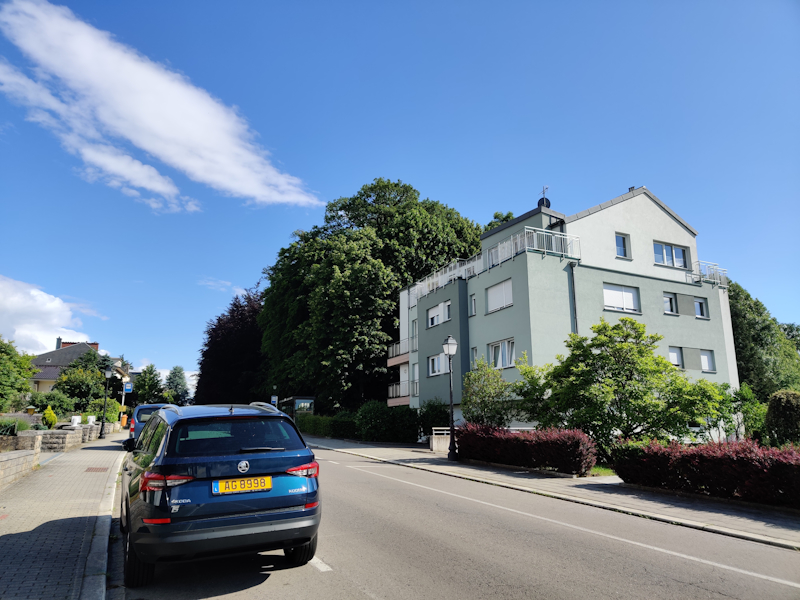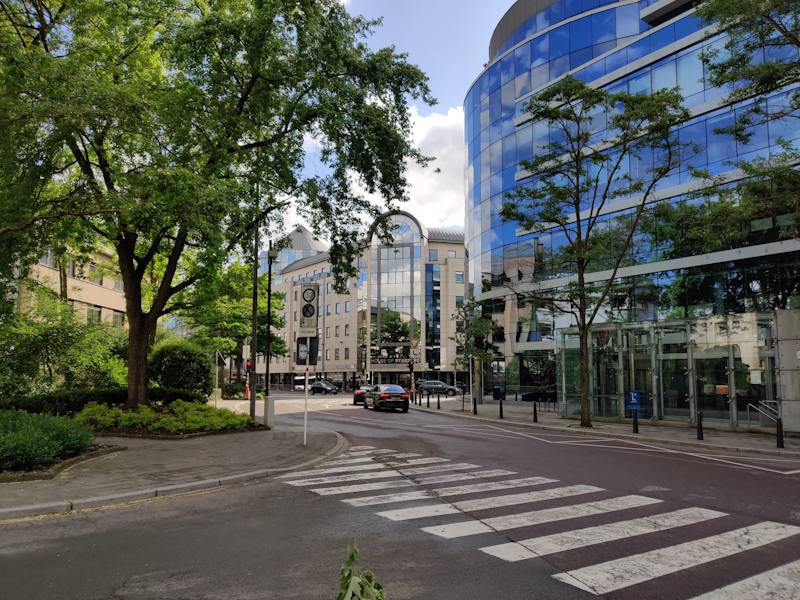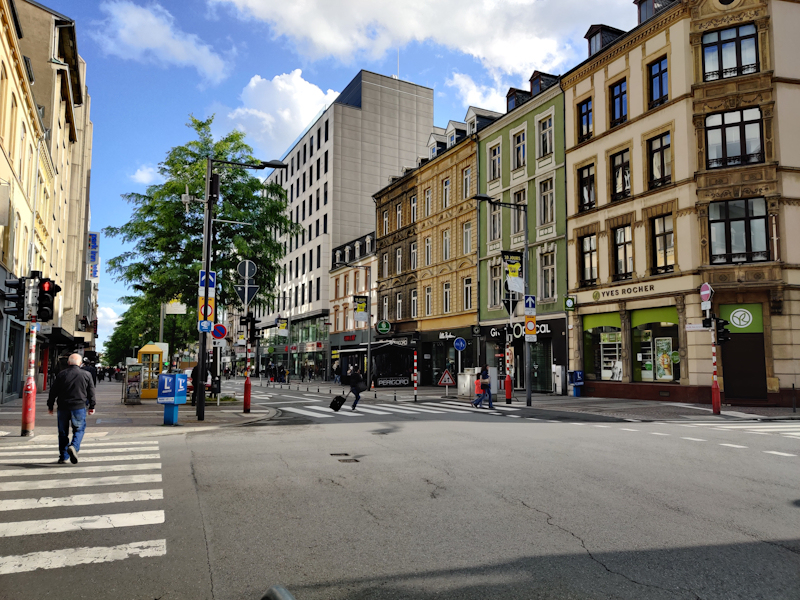The OnePlus 7 Pro Review: Outstanding Performance & Screen, Adequate Everything Else
by Andrei Frumusanu on June 19, 2019 12:00 PM EST- Posted in
- Mobile
- Smartphones
- OnePlus
- OnePlus 7 Pro
Camera - Daylight Evaluation
Having covered the OnePlus 7 Pro’s main feature, the 90Hz screen, the other major selling-point of the phone is its triple-camera setup.
The main camera is a 48MP Sony IMX586 sensor with an f/1.6 aperture lens and OIS. It’s to be noted that OnePlus does one thing right with the new sensor: It largely ignores the 48MP mode and is generally inaccessible besides in the Pro Mode. In general for all intents and purposes this is a 12MP camera shoot, and there’s nothing wrong with that. As we’ve seen reviewed in several other phones over the last year, the sensor’s native resolution capture mode comes with big compromises in terms of dynamic range and in 90% of the cases it’s not something I would recommend users to use.
The wide-angle and telephoto modules on the OP7Pro are also a first for the company, and allows the phone to match the features of the highest end Samsung and Huawei devices. We expect essentially every vendor this year to adopt the triple-camera setup in their flagships, so it’s a must-have in order to compete in the photography department.
Latest Firmware Update as of Writing
Also I have to make a big mention regarding the firmware version this review was written on: Initially I had already completed a camera testing round on the 9.5.5 firmware when I had received the phone, but then OnePlus had released the new OxygenOS 9.5.7 version which had major changes in the camera processing department as well as updating the Nightscape mode with a new improved algorithm, so I've redone the whole camera testing on the new firmware.
This review is also done with Samsung’s latest May firmware update on the Exynos S10 variant which also has major improvements, and coincidentally Huawei had also pushed a big update for the P30Pro which in turn also says to have improved camera performance.
It’s a bit annoying for us reviewers as camera performance is a continuously changing aspect of a new phone following its release (It’s one of the very last things OEMs spend development time on), but hopefully this review gives readers a good representative evaluation of what to expect of the phones for the rest of the year, including the new OnePlus 7 Pro.

[ OnePlus 7 Pro ] - [ OnePlus 6T ]
[ S10+ (E) ] - [ S10+ (S) ]
[ P30 Pro ] - [ Honor 20 Pro ]
[ G8 ] - [ Oppo Reno ]
[ Pixel 3 ] - [ Pixel 3a ] - [ iPhone XS ]
In the first scene there’s a lot of detail and high natural dynamic range as it was a clear day with the sun shining, while also having a lot of darker shadows in the scene.
The OP7Pro does a good job in terms of exposure and composition, however we do notice it lags behind the S10 in ability to capture the true brightness of the scene as well as the more natural saturation of the greenery.
I included the Honor 20 Pro into this review purposely because it has the very same IMX586 sensor as the OnePlus 7 Pro, with the differences between the two phones being that one is running on the Snapdragon 855 and the other is using the Kirin 980 chipset. Naturally each vendor’s camera calibration will also come into play here. This also applies to the Oppo Reno, again using the same popular sensor.
Unfortunately for the OP7Pro, the H20Pro has notably better colours and better HDR, something particularly visible on the highlights of the large hedges. The OnePlus tends to flatten things too much. The shadow captures also remind one very much of the Pixel 3, although it’s not quite as terrible as on the Google phone; here the S10 and iPhone XS’s dynamic range is just much better. OnePlus’ cousin the Oppo Reno also seems to have better handling of details throughout the scene as it’s not washing textures out as much.
We see about the same differences in the wide-angle lens of the OP7Pro: The composition is good, however things are flattened out too much as textures are washed out compared to other phones with wide-angle modules (Well, besides LG), albeit we are talking about different sensors this time around.

[ OnePlus 7 Pro ] - [ OnePlus 6T ]
[ S10+ (E) ] - [ S10+ (S) ]
[ P30 Pro ] - [ Honor 20 Pro ]
[ G8 ] - [ Oppo Reno ]
[ Pixel 3a ] - [ iPhone XS ]
This next scene was actually a bit shocking to me when I was sorting the pictures as I couldn’t believe just how many phones outright failed to get acceptable results. This was actually a sunny day with intermittent cloud cover, and the scene in question was overcast by a larger cloud during the captures. The background clouds however were extremely bright and I think a lot of phones failed because of this.
The OnePlus 6T’s result was particularly potato-quality as its HDR algorithm decided to get rid of all intensity levels beyond 75% luminosity. Overall I find it quite a pity with what OnePlus had done with the 6T as I deemed the OP6 last year to be among the best daytime cameras out there.
Nevertheless, this is about the 7 Pro, and here the new phone does a lot better than the 6T and it manages to get a reasonable exposure. Still it’s not really enough to keep up with the competition as the scene is too dark and the shadows in particularly are artificially too pronounced. The Exynos S10 fell flat when it came to colours, leaving the Snapdragon S10 as the only phone with a good representation of the scene, even if the background sky was blown out.
The wide-angle on the OP7 Pro is good, although again it’s having too dark shadows and the colour temperature is also slightly too warm. What’s interesting here is that in terms of viewing angle, the OP7 Pro is similar to other phones such as the H20Pro, Reno and G8, however the OnePlus has a massively more pronounced distortion on the lens, as seen by the curvature of the ledge at the bottom of the screen.
I found the zoom lens of the OP7 Pro here to be quite excellent. The 3x effective factor results in extremely sharp images throughout the scene, and although the exposure wasn’t challenging here, it was very good.

[ OnePlus 7 Pro ] - [ OnePlus 6T ]
[ S10+ (E) ] - [ S10+ (S) ]
[ P30 Pro ]
[ Honor 20 Pro ] - [ G8 ]
[ Oppo Reno ]
[ Pixel 3 ] - [ Pixel 3a ] - [ iPhone XS ]
The next scene is also an excellent showcase how having the same sensor doesn’t really mean too much in terms of the resulting picture: The OP7Pro, H20Pro and Reno have absolutely nothing in common in terms of the end image.
The picture’s histograms between the OP7Pro and Pixel 3 are shockingly similar, with both phones ending up with similar compositions. However they’re both too dark and wrong colour temperature (The 6T does much better here). The Galaxy S10 is the best representation of the actual scene.

[ OnePlus 7 Pro ] - [ OnePlus 6T ]
[ S10+ (E) ] - [ S10+ (S) ]
[ P30 Pro ] - [ Honor 20 Pro ]
[ G8 ] - [ Oppo Reno ]
[ Pixel 3 ] - [ Pixel 3a ] - [ iPhone XS ]
The next scene is a lot easier in terms of exposure and the OP7Pro ends up with a good composition. Its weaknesses is again similar to that of the Pixel 3 and older phones in that it doesn’t have any dynamic range in the shadows for what is essentially broad daylight.
The Honor 20 Pro showcases that the sensor is able to capture a lot more, and also it doesn’t wash out textures as seen on the OnePlus phone in the road, sidewalk and building façade.

[ OnePlus 7 Pro ] - [ OnePlus 6T ]
[ S10+ (E) ] - [ S10+ (S) ]
[ P30 Pro ] - [ Honor 20 Pro ] - [ G8 ]
[ Oppo Reno ] - [ Pixel 3 ] - [ Pixel 3a ] - [ iPhone XS ]
Continuing on a relatively bad streak, this next scene also isn’t too kind to the OP7Pro. Here it’s actually the 6T which best showcases the 7Pro’s lackings in terms of texture detail as well as shadow exposure. The Honor 20 Pro and Reno both again showcase the hardware should be able to achieve better.
The wide-angle here is good, although again lacking in shadows. It’s at least nice to see that OnePlus’ processing between the main and wide-angle is extremely similar with little to no difference in the vast majority of scenarios, so that’s a plus.

[ OnePlus 7 Pro ] - [ OnePlus 6T ]
[ S10+ (E) ] - [ S10+ (S) ]
[ P30 Pro ] - [ Honor 20 Pro ]
[ G8 ] - [ Oppo Reno ]
[ Pixel 3 ] - [ Pixel 3a ] - [ iPhone XS ]
This last every-day scene again showcases the OP7Pro’s tendency to seemingly destroy shadows and the best example of this is the 6T. Even though the 6T has its own issues here such as flattening highlights too much, it’s able to accurately portray the shop fronts while the OP7 tends to almost clip to black (And actually does so).
The wide angle here did some quite aggressive HDR and brought down the sun-lit foreground street to almost the same levels as the shadow cast parts, something the P30 Pro also erroneously decided to do.
The telephoto module here again performed excellently, resolving a fantastic amount of detail at this magnification level. The only odd thing is that the saturation intensities are quite low, and elements such as the “Coolcat” shop logo ended up completely muted compared to all other phones’ telephoto modules.

[ OnePlus 7 Pro ] - [ OnePlus 6T ]
[ S10+ (E) ] - [ S10+ (S) ]
[ P30 Pro ] - [ Honor 20 Pro ]
[ G8 ] - [ Oppo Reno ]
[ Pixel 3 ] - [ Pixel 3a ] - [ iPhone XS ]
Finally this last scene is just a hard task for any phone and simply a test of the raw dynamic range of the phones; taking a picture against the sun.
The OP7Pro still manages to get good black points in post-processing, although doesn’t match Huawei or Samsung in terms of dynamic range. Oddly enough the phone’s wide-angle achieves a lot better results here.
The telephoto also does very well in prioritising the actual scene, as opposed to the dark shots of the P30Pro and Honor 20 Pro.
Daylight Camera Conclusion
Overall, I was relatively disappointed by the OnePlus 7 Pro’s daylight capture performance. Having the Honor 20 Pro and the Oppo Reno in this camera comparison has showcased that this isn’t inherently an issue of the camera’s hardware and the Sony IMX586 sensor, but rather something on the part of OnePlus’ camera calibration and post-processing algorithms.
The two most egregious issues with the main camera sensor shot is the fact that OnePlus tends to wash out textures a lot more, and that it gives too little priority to shadows. The first issue is actually quite bad in some cases as we’ve had some shots in which the OnePlus 6T actually fared better.
The issue of the dark and even clipped shadows reminds me a lot of the Pixel’s processing. I do really hope that OnePlus wasn’t trying to mimic Google’s processing here and that this is just an issue of the exposure algorithms rather than an intentional post-processing effect in order to add contrast to the pictures. I was never impressed by this part of the Pixel’s camera and is easily the single worst aspect for OnePlus to have in common with.
The wide-angle module, much like on other phones, is an outstanding addition to the capture experience of the phone. In terms of actual picture results, it shares the same processing issues as the main camera. While this is to expected of a wide-angle module, the chromatic aberrations and distortions on the very edges of the frame are exceptionally pronounced on the OP7Pro, pointing out to rather low quality optics.
Finally, I didn’t have any major issues with the new 3x telephoto lens. I was actually quite impressed by the detail the module was able to resolve, and I don’t feel it has as many processing issues as the other two modules.
Overall, whilst the OnePlus 7 Pro’s camera in daylight isn’t outright bad, it really can’t claim it’s a flagship killer as it gets bested by a lot of phones, including from Huawei, Honor, Samsung.










91 Comments
View All Comments
DillholeMcRib - Wednesday, June 19, 2019 - link
Can I flash this damn thing and run WIndows ARM on it?Jez1 - Wednesday, June 19, 2019 - link
I had this around a week and they were great things about it, but many things I didn't like so returned it.The screen was great and apps installed at an amazing pace, the UI was lovely but to many negatives. The camera was so erratic and one minute would take a nice photo, then the next would have washed out colors and lacked detail and sharpness when slightly zoomed in. A lot of the time my old S7 took more reliable photos and my wife's 6T was also better. I know this could get better with fixes, but was too poor out of the box.
The sides of the screen also got massive reflections outside and the inbuilt screen protector was rubbish. In a week of light use, it was covered in indention's from my nail and also stated getting air bubbles. So you couldn't even appreciate the lovely screen and there wasn't any 3rd party ones available.
The final thing which is subjective is the weight, it felt so heavy one-handed.
I then got a s10+ and and couldn't be happier with in comparison. I got a big discount for my old bashed up S7, so only paid £40 more. I hope OnePlus can get it together for their next phone as love their approach and really didn't want to get another Samsung
Quantumz0d - Wednesday, June 19, 2019 - link
With this phone OnePlus went full marketing mumbojumbo.They spent a lot of cash on that only and while sidetracking all the negatives this phone has. 90Hz is a gimmick, so many people don't want that. Instead they want a phone which is marked at $700 these -
- A 3.5mm headphone jack, (How come the 6T dropped the jack saying no space for the finger print scanner while they crammed a motorized camera into the chassis, It's plain BS as always with Apple or any company, Note had S-Pen, LG has Display fused OLED crystal sound with proper ToF camera with an ESS DAC equipped phone)
- No SD card slot, No don't say cloud or 256GB, I have a ton of data on my PC FHD high bitrate movies, 4K UHD recording directly to SD card pictures to SD card, High quality recording of Audio through Stereo and high bitrate likes of LG, Emulators, FLAC/DSD files etc and top of all, a fully reliable offline cheap storage which just works and offers expansion as per user choice from 128GB to 1TB.
- No IP rating, No the damn shilled tests from Dave2D or MHBHD aren't going to cut it, the IEC conventions are internationally agreed standards not some bs offscreen tests saying it increases price and all rubbish kool-aid.
- Trash camera
- No QI wireless charging, glass back and peanuts charging, they don't wnat to give because they want to milk with all these features barring the jack for another refresh or new unit.
- No price cuts, OP phones never get a price cut, today you can buy an SD835 (By no means a problem) phones like S8+ for 500USD which has everything more than this gimmick phone, LG phones see price cuts, got my V30S for far less price under 500USD which outperforms in all features, Yes even the BL unlock, coming to that, S9 and Note 9 are cheaper at $600USD which again rape this phone to oblivion esp Exynos models which have BL unlock. And the latest S10 is already seeing discounts, and once Black Friday hits the G8 and all phones will drop price.
Next is Zenfone6 that phone is making waves apart from the mediocre LCD display (No pentile, so FHD is fine but the brightness is not enough) and it has 3.5mm jack, Stereo speakers, a big arse 5000MaH battery without this over charging current rate.
Huge thanks to Andrei a lot for this piece on this stupid overdrive current charging done by Oneplus, fools at many blogs and youtube shills refuse to believe me that over high currrent charging is insane simply due to the cathode-anode reactions and faster degradation, esp this is why we need Qi not battery raping marketing BS. These oneplus garbage phones always overcharge and do this rubbish, look at QC with Samsung/LG/Sony any company apart from this and Huawei have that, Apple even sandbags the battery death by reducing the CPU perf. This BS is not seen my 99% of the people and they end up with junk on top of the non user replaceable batteries.
So all in all this is an overpriced "toy" not a proper pocket PC / Powerful computer in your hand.
Quantumz0d - Wednesday, June 19, 2019 - link
Edit - Zenfone 6 specs include - it also got UFS storage unlike Pixel 3a with eMMC trash, an SD855 a great camera than this junk well, at-least from the users, an SD slot, Bootloader unlock and highest SKU is less than 600USD (8GB/256GB)zodiacfml - Thursday, June 20, 2019 - link
I agree especially on the LCD display. I have a lot of praise for OLED until I got it for the first time in the S8+. It is easily not as sharp as my Nexus 5. Every time I open the Nexus 5, I'm taken away how sharp and clean the display is versus the AMOLED S8. I have late 30's eyes. I'd rather take an LCD display for my next phone as long it is reasonably priced vs premium OLED phones.I disagree with your fast charging criticism though. I'm no battery enthusiast, if rapid charging kills batteries, then we should not see them in electric vehicles such as Tesla cars.
My Nexus 5 doesn't have rapid charging tech but my second battery is, again, bulging with less capacity. It does heat a lot though with Data turned and/or during gaming. Certainly, it is heat is the detrimental effect and heat is only the effect of fast charging
Andrei Frumusanu - Thursday, June 20, 2019 - link
> if rapid charging kills batteries, then we should not see them in electric vehicles such as Tesla cars.Tesla batteries are also gigantic (In comparison to a regular wall outlet power) and designed to handle that.
We've had a smartphone vendor who promoted one of these super-high charging rate confirm some pretty atrocious long-term capacity degradation, while something like Samsung's degradation curve was like 20% higher in terms of retained capacity after the same amount of cycles.
zodiacfml - Thursday, June 20, 2019 - link
I refer to Tesla's Superchargers where a Model 3 can charge to 80 percent in 30 minutes. A Supercharger charges its battery cells as fast as quick charging smartphones.OP can afford a faster charging rate than Qualcomm's QC because there is no voltage conversion happening in OP's phone, thus less heat. The only drawback only works with OP's charger and thick cable.
rabidpeach - Tuesday, June 22, 2021 - link
sorry it's been years but hopefully the future readership realizes that TESLA herself encourages you to NOT supercharge the car constantly as that would increase the degradation as well as well-reported constant fleet usage of supercharge style system has shown degradation.Xyler94 - Thursday, June 20, 2019 - link
I will always prefer my AMOLED displays in phones. OLEDs have the advantage of having much higher contrast than LCD, because individual pixels can be turned fully off, creating true black. There's no LCD that can do that. LED LCDs come close, but only because you can turn off zones of the LED backlight.Also, colour calibration makes an image look better than the display tech. If the Nexus 5 had better calibration, then it would definitely be a better display. I know Samsung TVs always have too much blue (I've calibrated a few of them), it's possible their phone displays have a bit too much blue too.
zodiacfml - Thursday, June 20, 2019 - link
That's what I thought which led me to buy the Samsung. I realized, the infinite contrast has little value to me except watching movies in darkness.The sharpness of the LCD over the pen-tile AMOLED is noticeable with text, sharper edges with LCDs. Images from my DSLRs or conventional cameras are also sharper on the N5.
White background in AMOLED never convinced me, feels rough or dirty. I checked today, looked at my Samsung around 4 inches away, I can notice multicolored very tiny noise-like pixels.
The Nexus 5 has one of the best calibrated displays during its time. I'm just saying LCDs superior to AMOLEDs in image sharpness alone